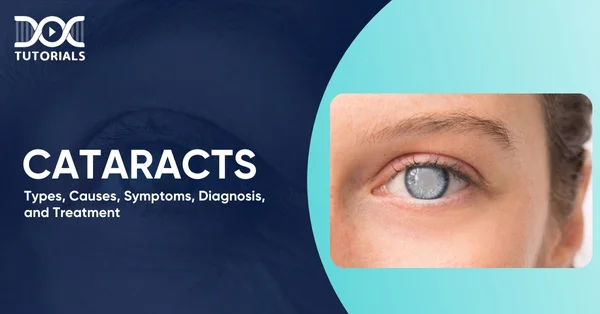Cataracts | Types, Causes, Symptoms, Diagnosis, and Treatment

Cataracts are a common eye condition that develops when the eye’s natural lens becomes cloudy, leading to blurred or dimmed vision. Initially, it might not be noticeable, but over time, it can interfere with daily activities such as reading, driving, and recognising people.
While cataracts can affect anyone, they are mainly associated with ageing and are a leading cause of vision loss in older people. In fact, cataracts affect more than half of the people by the age of 80, making it the most common eye issue worldwide. However, with early detection and treatment, cataracts can be effectively treated.
If you’re a medical candidate studying for the NEET PG exam, it is essential to understand the causes, symptoms, diagnosis, treatments, and types of cataracts. Keep reading for detailed insights.
What are Cataracts?
Cataracts are cloudy layers that form in the lens, the clear part of the eye. These cloudy layers make it difficult for light to pass through and reach the retina. If left untreated, this condition can cause distortion of vision and lead to partial or complete loss of vision.
The lens of the eyes plays a crucial role in focusing light and helping us see clear images. They are mostly made up of a protein called crystallin, which breaks down as you age, forming cloudy patches in your eye. When cataracts form, they appear like a foggy, frosty window, causing the vision to become blurry, hazy, and less colourful.
What are the Types of Cataracts?
There are several types of cataracts. Different factors cause each of them and affect various parts of the eye. They are primarily classified based on their causes and locations, as follows:
- Cataracts Based on Causes
These cataracts are categorised based on their development. Some are age-related, while others are caused by injury, illness, or medication.
- Age-Related (Senile) Cataract
Senile cataract is the most common type and typically develops as you age, usually after the age of 50. It forms slowly and can affect one or both eyes, causing cloudy vision, glare, and faded colours over time.
- Traumatic Cataract
These develop after an injury to the eye, typically caused by a sharp object or blunt force. The cataract may appear immediately or after years, depending on the extent of damage to the lens.
- Diabetic Snowflake Cataract
The snowflake cataract is mainly seen in younger people with uncontrolled diabetes. It forms quickly and gets its name from its distinctive snowflake appearance in the lens of the eye, and leads to sudden vision changes.
- Radiation Cataract
These cataracts develop due to prolonged exposure to radiation, such as UV (ultraviolet) rays or radiation therapy. They usually form at the back of the lens and affect both eyes over time.
- Pediatric (Congenital or developmental) Cataract
This type of cataract is present at birth or develops during early childhood, and can be inherited or caused by infections during pregnancy. They can lead to permanent vision problems if left untreated.
- Secondary Cataract
This type of cataract can affect your vision even after a cataract surgery due to the development of scar tissue. Posterior capsular opacification is another term for this condition. It is a common and treatable type of cataract.
- Cataracts Based on Location
These cataract types are categorised by where the clouding occurs in the lens of the eye. The location affects how quickly symptoms appear and the kind of vision problems the patient may notice.
- Capsular Cataract
This type of cataract occurs in the thin capsule that holds the lens in place. It can form in either the front part of the capsule (anterior) or the back (posterior), often following surgery or trauma.
- Subcapsular Cataract
This type of cataract develops beneath the capsule, usually at the back (posterior subcapsular cataract), causing glare and affecting reading, especially in bright light. It tends to progress faster than other types of cataract.
- Cortical Cataract
The cortical cataract begins at the outer part of the lens (cortex) and moves inward. As it grows, it alters the light passing through the centre, causing light scatter, glare, and halos, especially at night.
- Nuclear Cataract
Nuclear cataract affects the central zone of the lens, specifically the nucleus. It is the most common age-related cataract, causing blurring and yellowing of vision over time.
- Polar Cataract
Polar cataracts develop at the front (anterior polar) or back (posterior polar) pole of the lens. They are congenital and can be challenging to remove through surgery sometimes.
What are the Causes of Cataracts?
Cataracts can be developed for several reasons, with ageing being one of the most common causes. As you age, the proteins in your eyes break down and clump together, resulting in cloudiness in your eyes. However, there can be many other factors that cause cataracts, such as:
- Genetics
- Diabetes
- Smoking
- Excessive sun exposure (UV radiation)
- Eye injuries
- Long-term use of steroids
- Excessive alcohol
- Obesity
- Air pollution
- Industrial chemicals
- Pesticides
What are the Symptoms of Cataracts?
Cataracts typically develop slowly, and you may not notice any changes in the early cataract stages. However, as it progresses and the clouding of the lens worsens, several vision problems begin to appear. The symptoms include:
- Dim, blurry, or clouded vision
- Changes in the way colours appear
- Trouble seeing at night
- Sensitivity to bright lights, headlights, and sunlight
- Frequent changes in contact lenses and glasses prescriptions
- Appearance of halos or glare around lights
- Requiring brighter light for reading
- Double vision in one eye
What is the Diagnosis of Cataracts?
Cataracts are diagnosed through a comprehensive eye examination. The ophthalmologist or optometrist will closely examine the eyes for any signs and symptoms of cataracts and check their severity.
They will also assess the discomfort with everyday activities, vision, and family medical history, as the patient may not be able to see as well as they did. Other tests to diagnose include:
- Visual acuity test
- Slit lamp exam
What are the Treatments for Cataracts?
Surgery is the only effective way to remove cataracts. However, it might not be the first recommendation during the early stages. The treatment options can be:
- Home Treatment: Includes managing early-stage symptoms with sunglasses, magnifying lenses, improved lighting, or anti-glare sunglasses to help reduce visual discomfort.
- New Contacts or Glasses: These can be prescribed to help patients have clearer vision in the early stage of cataracts.
- Surgery: It is performed when cataracts begin to interfere with daily activities and cause severe discomfort. During surgery, the doctor will remove the clouded lenses and replace them with new artificial lenses, also known as intraocular lenses (IOLs).
FAQs about Cataracts
- What is the main cause of cataracts?
The main cause of cataracts is ageing. This is due to the natural breakdown of protein in the lenses, which causes it to clump together and form a cloudy structure within the lens.
- Can I live with cataracts without surgery?
This depends on the severity of the problem. If cataracts are not affecting your field of vision and not interfering with your daily activities, the symptoms can be managed with sunglasses, anti-glare glasses, and contact lenses. Once it becomes severe, surgery might be needed.
- How to stop cataracts from growing?
According to several studies, cataracts can be prevented by consuming foods rich in healthy vitamins C and E, as well as lutein and zeaxanthin. They also help slow the progression of cataracts.
- What is the best way to treat cataracts?
Surgery is the most effective way to treat cataracts, as it removes the cloudy lenses and replaces them with a fresh pair of artificial lenses for clearer vision.
- Is cataract surgery painful?
Cataract surgery is generally painless for most patients. The procedure uses topical eye drops to numb the eye so the patients won’t feel pain. At most, some people may experience slight pressure or discomfort during the surgery.
Conclusion
Cataracts are a common and manageable eye condition that can affect anyone, but primarily affects people over 40 or 50 years old. While it progresses slowly and the treatments can be managed with specific measures, such as sunglasses and contact lenses, it is essential to recognise when the treatment is necessary.
Treating cataracts on time can help prevent permanent vision loss or impairment. If you are a NEET PG student, DocTutorials offers a range of resources, including expert guidance, in-depth video lectures, test series, and more.
Join DocTutorials today and check out our NEET PG course!
Latest Blogs
-

NEET SS Exam 2024: Analysis, Key Dates, Counselling
The NEET SS 2024 exam kicked off on March 29, 2025. Over two days and two slots, candidates across 13…
-

NEET PG Registration 2025: An Essential Guide For Exam Prep
The NEET PG registration, which is conducted online, is a crucial step in the exam process. Filling out the NEET…
-

NEET PG Syllabus 2026: A Must-Have Complete Guide for Exam Success
The NEET PG Syllabus acts as one of the foundation stones for aspiring postgraduate medical students like you who are…




